I really wanted old-looking white floors for our new studio space. I actually saw some interesting, beat-up knotty oak at Lumber Liquidators for a little more than a dollar per square foot, which is practically highway robbery when it comes to wood flooring prices. But it was only about 2″ wide and after laying all that tongue-and-groove flooring on the other side of our house this year, I decided to think outside the box and figure out a way to get wide-plank wood flooring to go in the studio for way, way less.
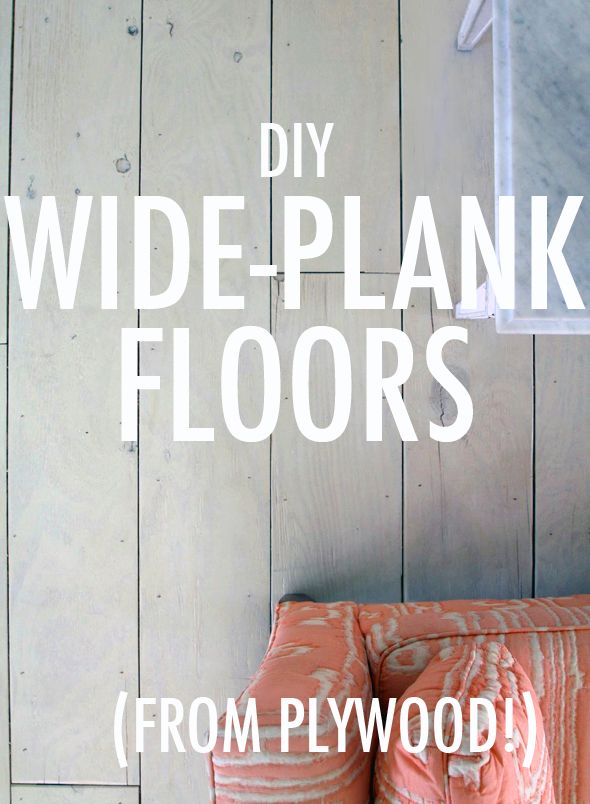
So there’s this really cool event space in Manhattan called Gary’s Loft that companies love to host parties at. One of the spaces is big and open and all white, with gorgeous, gappy wide-plank white wood floors. I loved going to parties at Gary’s.

When I was planning my approach to the DIY, I had those gorgeous floors in mind. They were perfectly imperfect and all worn and full of character. I had the thought that cutting down and using plywood as the planks could achieve a similar, and even more rustic (in a good way) look. So I headed to the lumber section at my local Home Depot and found just the right plywood. It’s almost a half-inch thick and one side is more finished than the other.

Plywood sheets are 4×8′, which is 32 square feet. We needed to install about 800 square feet of flooring up in the studio space with the attached bedroom and balcony. Which meant we needed about 25 sheets of plywood. At less than $18 per sheet, my price per square foot came in at about 50 cents, which is complete insanity!

So, I found the plywood I wanted, took a photo of the price tag, and walked up to the customer service desk. I placed an order for 25 sheets and I asked for each sheet to be cut down into 8″ planks, lengthwise (which meant there was no waste – exactly six planks from each sheet). I’ll admit that I did get a few funny looks, but for the most part everyone at Home Depot was incredibly nice and accomodating, given the huge ask. I was more than prepared to pay 10 or even 25 cents per cut, like one of the guys in the lumber department suggested they might charge me at the order desk. I think I paid for cuts when I did the wall planking project in our mudroom, but this time there was no charge for all those cuts! I’m pretty sure it was because I was really flexible on timing and let them take as long as they wanted to get the order finished. And even then, it was less than 24 hours before they called to tell me my planks were ready to be picked up.

We borrowed a truck from my kind brother in law and he and the Home Depot guys helped us load up the 25 sheets of cut wood. The tricky part was then getting all the wood upstairs! These amazing gloves practically never left my hands during the two or so days I was installing the planks and moving them around. The gloves are thin, but really durable and they grip so well that you almost forget you’re wearing gloves at all. They’re my favorite brand I’ve used so far.
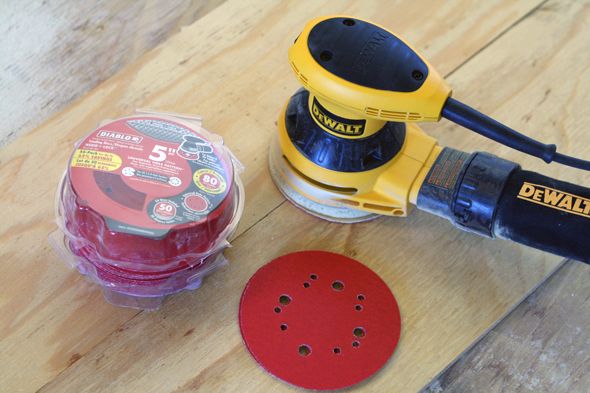
Once we had all the carpet removed and all the wood planks upstairs to the back porch, it was time to start the only tedious part of this project: all the sanding. It was actually pretty easy work, but it just took some time (actually about a minute and a half or two per plank, which really adds up). I asked Heather to sand while I was installing the planks, and usually the timing worked out well and we were able to keep a good pace.
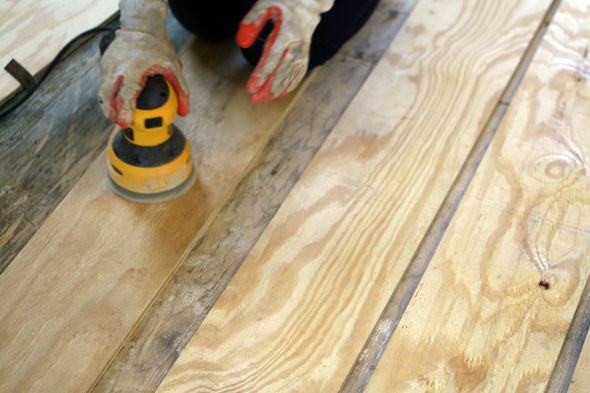
This new orbital sander has changed my LIFE. You guys, what have I been doing with my dorky little Mouse sander for all these years?! Orbital is where it’s at. Worth every last penny.

I bought a couple packages of the bulk 60-count course/removal sanding pads and they really worked fast on any rough parts or spray painted markings or splinters on the plywood planks. It worked out best to change the sanding pad every three or four planks. And I didn’t worry about getting every imperfection off – you’re just going for the obvious parts that look bad or like they could hurt a bare foot. We also sanded down the perimeter of every plank so that the edges were sort of beveled. I think this step made a huge difference in helping the planks look like they’re not just cut down plywood pieces.

The installing part was so easy, especially when there weren’t additional cuts needed. You’ll want to start on the longest, straightest wall you have. Don’t start on a wall that requires a lot of cuts and notching out – your lines will get messy and crooked really fast. If you start your installation on a long, straight wall and just focus on maintaining even spacing, the planks will look great. You can use a ruler or t-square to help with spacing, but I felt comfortable eyeing it.
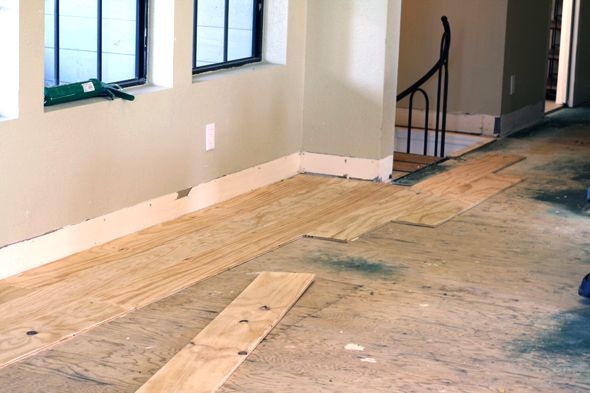
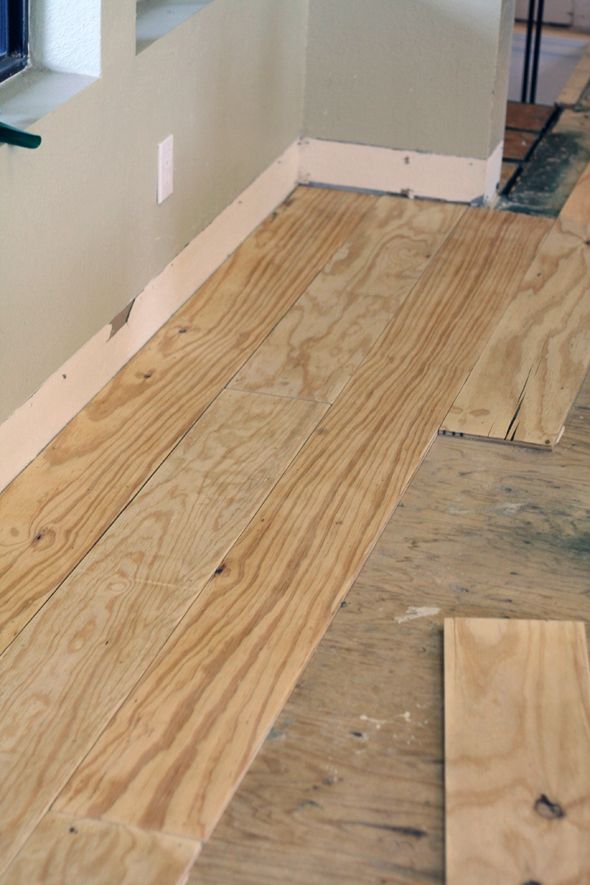
To lay the wood down, I first squiggled on to the back side of the planks a line of Subfloor Liquid Nails (in the big contractor size, using the oversized caulking gun). I went through at least a dozen of these tubes of glue – you’ll need a lot of it!
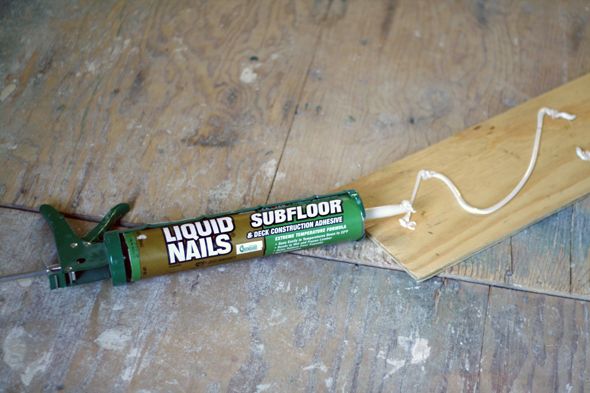
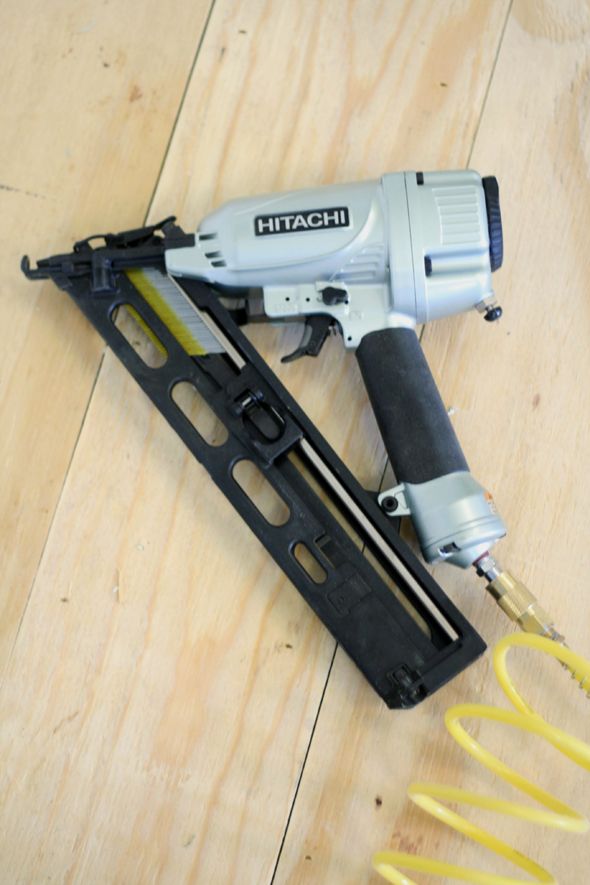
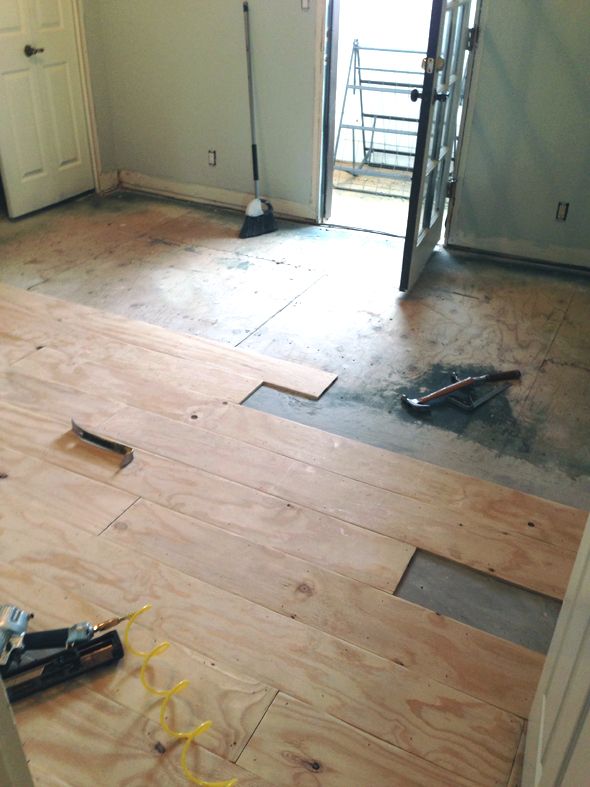

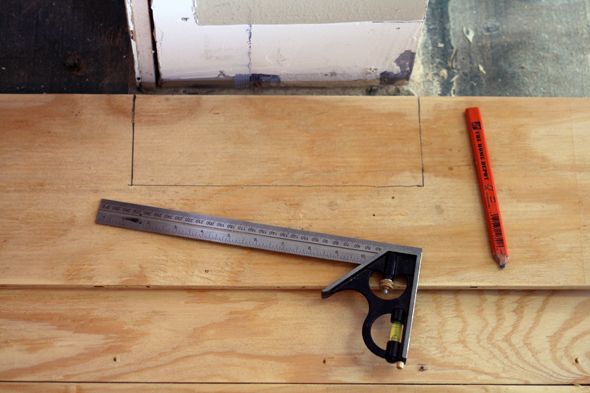
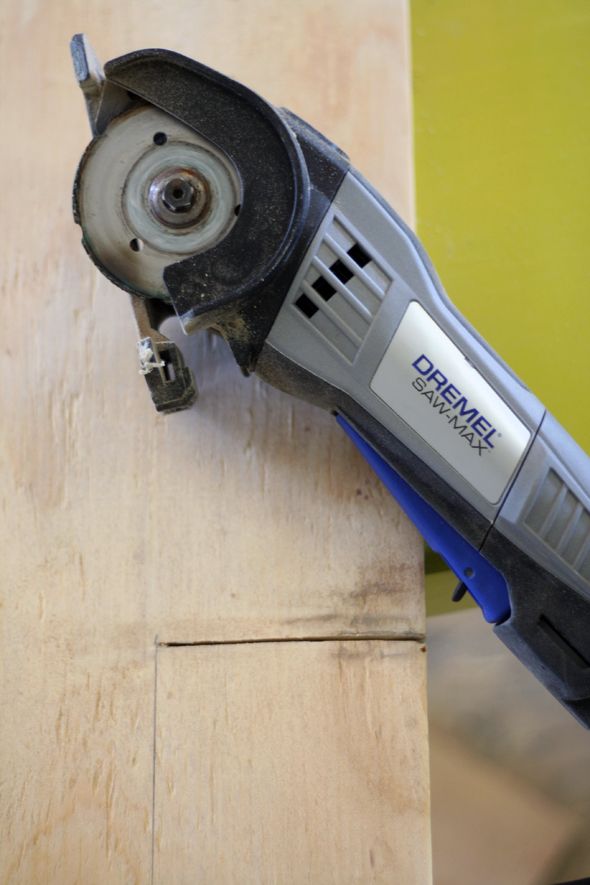


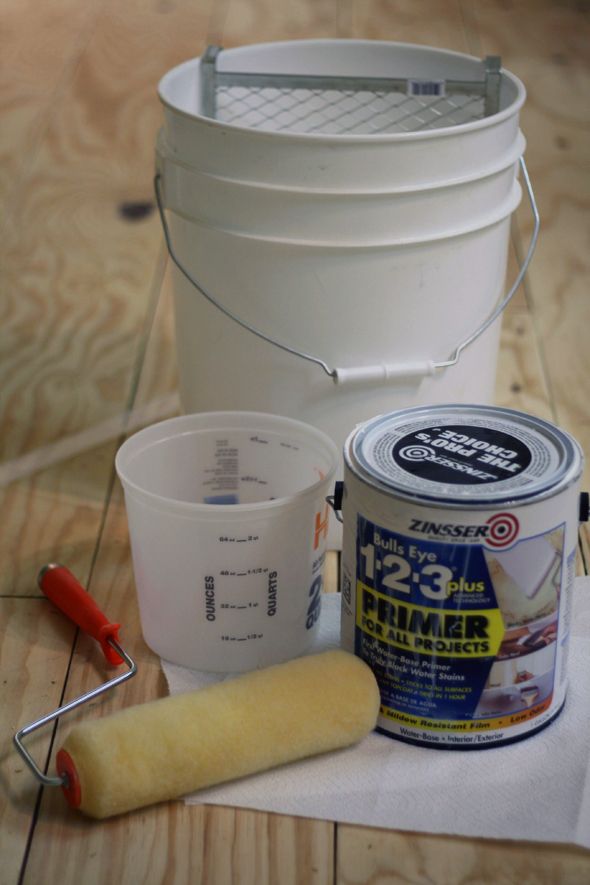
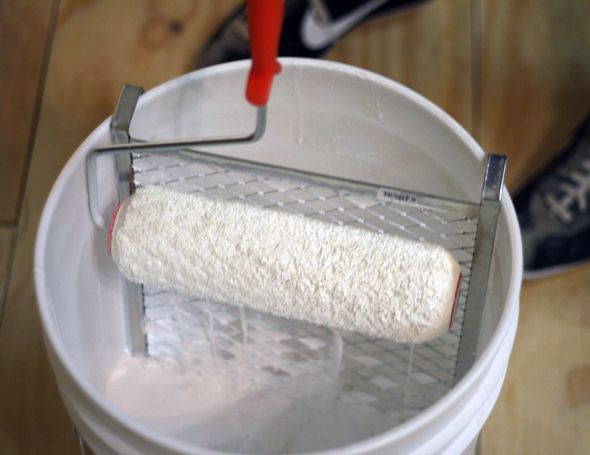


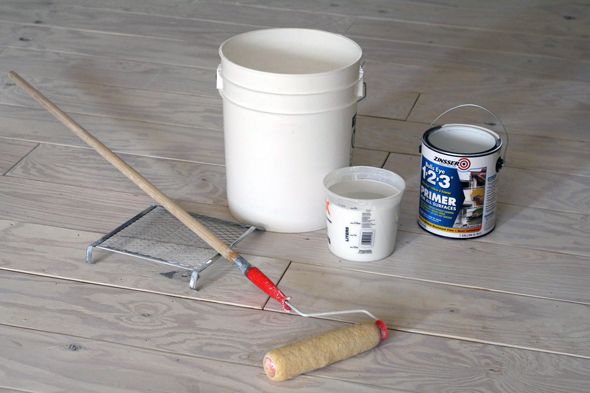

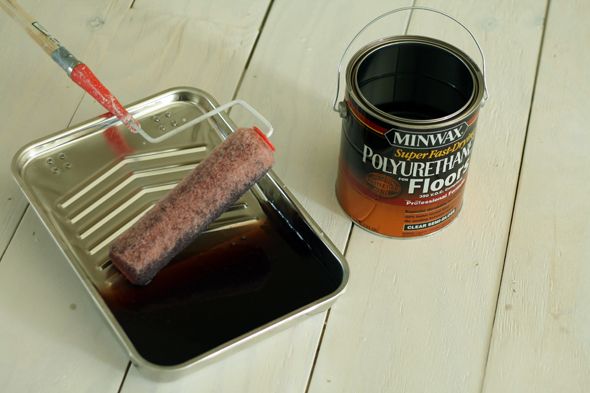

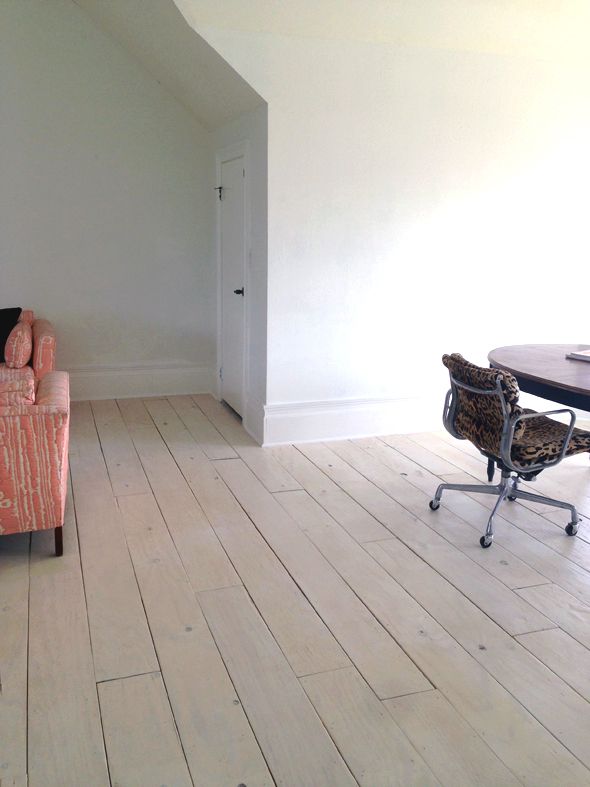
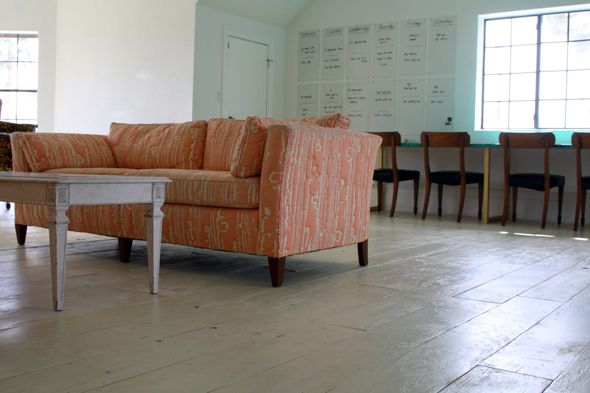


We haven’t even started decorating in here yet, but I LOVE how bright the space feels now! Remember how dark it was just a few short weeks ago?
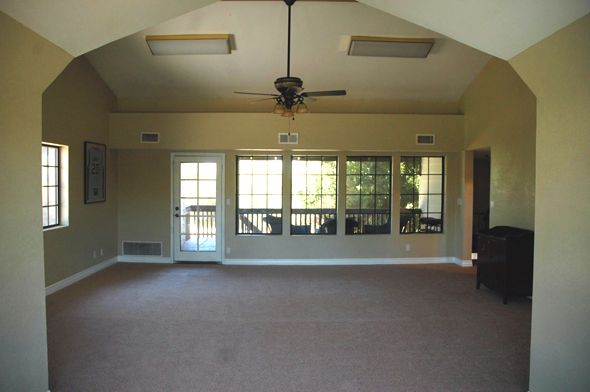
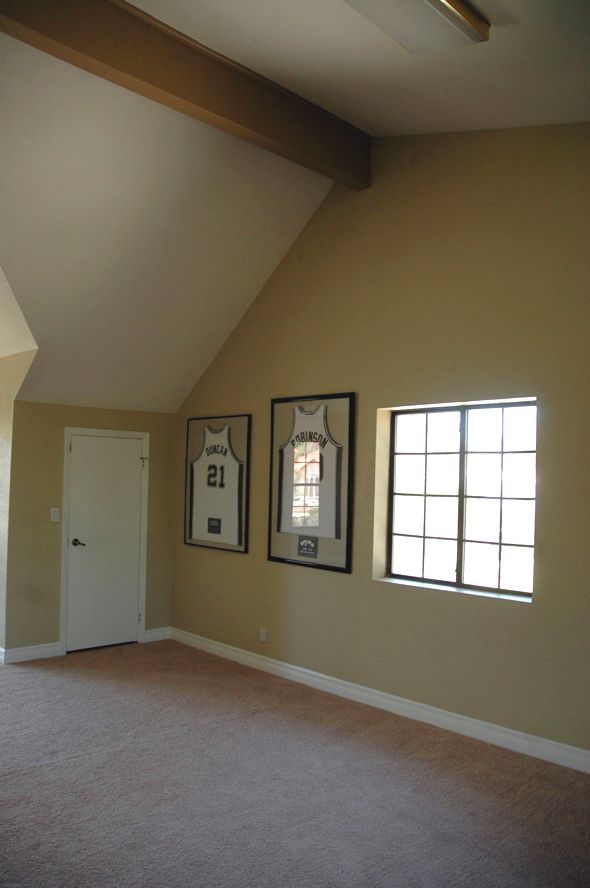


The floors have completely changed the way I feel about this space! Instant character!

And at only 50 cents a square foot for the plywood, it’s hard to find things to complain about. It’s a great look, especially for the price.

The studio is becoming a really lovely place to get work done and I know it will be perfect for photographing projects for the blog and book. We get great light in here all hours of the day and all the shades of white make the room just glow. :)



Now, on to the decorating!

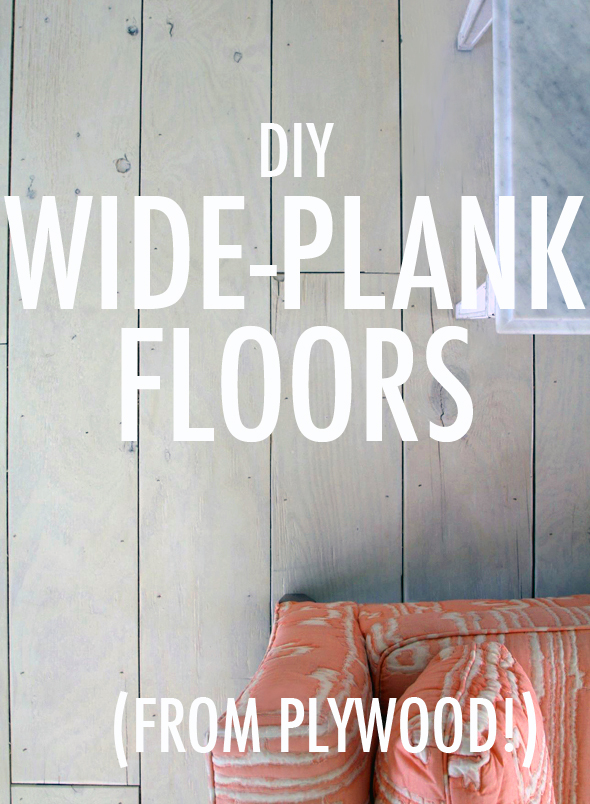


hi,
absolutely love this idea. how are the floors holding up?
They are great! If I were to do it again, I would pay a little more for a higher quality plywood, but I still love them! If you look on my instagram stories highlights, you’ll see some video of the floors after a few years of wear and tear. Hope that helps!
what is your instagram so I can check out the floors after a few years?
My instagram is @jennykomenda
Beautiful project. Do you think this would work for walls, too?
Absolutely!
Beautiful project. Do you think this would work for walls?
For sure! You might want to look into a product called Bender Board as well!
What’s up,I log on to your blog named “DIY Wide-Plank Floors (Made from Plywood!) – Little Green Notebook” like every week.Your humoristic style is witty, keep doing what you’re doing! And you can look our website about proxy list daily.
What do you do to seal the joints to keep the dirt out?
What a great idea, never thought of this and it is functional at a super low cost. As far as cleaning it regularly, I think sweeping in the direction of the grooves would get most dirt, sand, etc., along with a strong shop vac maybe once every month or two to suck out anything the broom can’t dislodge.
Great idea,,,, must try!
Thank you so much for this WONDERFUL idea! I just finished this in our basement where I am building an office/studio. I upgraded to a more expensive finish on the plywood (out of laziness, truly) and finished it with a clear poly. It looks so lovely! And it was SO easy to do! Took only a couple days including the poly coating. Thank you, again!
Did you stain your plywood? What finish did you end up using?
Great post but I too would appreciate you answering the questions.
Your space is gorgeous!
Back in 2010 I thought I had been the only one to use this plywood, which we painted high gloss white – there’s nothing new under the sun. lol! We put the same in our next small cottage. It’s 2018 & we’re in a much larger home & going to do your whitewash technique for a fresher look. (Doing a happy dance)
This is an awesome idea! Fantastic job!!! We just took over the family farm and did a house swap with my in-laws at the same time, ugh. 20 years of water damage & neglect. The floors are awful and we haven’t much money, after opening many cans of worms, we are still living in our vintage camper next to the barn. I’ve been bummed til now… This technique will allow us to buy bit by bit and maybe by fall, we’ll have enough to do the whole house over next winter. I am very excited, thank you so much for sharing!
Ite a great idea and post but superfluously crappy that you don’t answer the one question everyone wants an answer to.
Hi Jane!
This post is quite a few years old at this point, so I don’t see all the comments coming through. I’m happy to answers any of your questions though if you want to respond here or send me an email!
Thanks and sorry for the delay,
Jenny
love the idea and look forward to start the project in a large room that we use as a family room, huge question! The existing floor is an old vinyl floor, but in good condition, do I need to remove the vinyl? Obviously, it would be so much easier not to have to go through the agony of removing the vinyl and all the crap and glue that would be a major project in itself!
Thank you,
Randy
Hi Randy, Do you have vinyl on plywood subfloors? These plywood planks cannot be installed on slab without using a lot of glue and a moisture barrier paper.
After reading your post and all the equipment you purchased it would of been less expensive and easier to buy it already made with less work and time. Looks okay though.
I had a lot of these tools already! Totally can see why someone would not want to do this DIY, but it’s a great option for others.
Hi there!
Awesome flooring tutorial! I followed your tutorial and did the same two years ago! Thank you.
Our floor has since picked up lots of dings, scratches and marks and we’d like to give it a freshen up and whiten it up again.
We used poly as a sealer (like you), however we’d like to make it whiter and cleaner, and putting another coat of poly on top will just cover up the marks we have now.
Do you know if it’s possible to apply something like a different white varnish straight over the poly?
I do not want to remove the old poly as it’s far too much work!
How have you maintained the floor?
Many thanks in advance!
Hi! We just recoat the floor paint as needed!
Just wondering how these floors have held up over the years?
They’ve held up fine! We touch up the floor paint as needed. We did an addition to this area and I like the floors so much I’ll be laying more rather than replacing! While I have the nail gun out, I’ll probably put a few more nails in a couple of boards that are slightly raised, but I’m still happy with these.
I’m not sure if I’m making a mistake. I have BEAUTIFUL hard wood floors, they just need sanded. I think I want to put plywood floors down. Is this a good idea? Or should I just have my good floors sanded?
Hi. I know someone who had real wood flooring thru out. He told me they could be sanded and refinished three times before they would probably need replacing. Just saying.
I absolutely would have your floors refinished instead of this method. This is meant to be a cost effective alternative for new flooring. Refinishing wood floors is only a few dollars per sq ft!
Do you think the same process that you did for the flooring could be as a backsplash in the kitchen?
I would not recommend using wood on a backsplash! It can’t be used behind a stove for sure.
I think plywood is made of very thin layers of wood, so I am not sure of the durability of the floor. Also I think that the separation between the planks will allow a lot of dust to get inside.
Hi Charlie, No problems with the thin layers of wood – that’s how all engineered wood is made. But you’re right about the wide seams we used. I like the look, but it does collect dust!
Absolutely love the fresh light look. Your directions and explanations are concise and interesting. Thanks for sharing! I can’t wait to try this.
Thanks Linda! :)
Seriously wish I had found this before I spent $1000 (all totaled) for cheap laminate, 3/8″ plywood underlayment (to raise the finished floor to the same height as my wood floor in kitchen/dining area) and good quality sound proofing/vapor barrier for one 15×17 room! Then, to add insult to injury, somewhere in the fine print on the enclosed paperwork, it stated do NOT mop the floors! Supposed to be high traffic laminate but you can mop??? I will be putting this down in the rest of the rooms, for sure.
Thank you for taking the time to explain everything. There are not many people ( especially carpenters) who will tell their trick, because they want to keep us dependent on their expertise.
Please take a couple of hours and answer people’s questions!! My goodness! You replied to one and asked her to send you an
e-mail with her questions.
Hi Tracy. This post is very old and I don’t always see the comments come through. I have thousands of blog posts on this site – so you can imagine how tricky it would be to keep an eye on the comments for every single post. I do my best to respond. If anyone needs immediate feedback, they are welcome to email or DM me on instagram and I always get back to people there. Thanks, Jenny
I think you should ignore the cranky people. The floors are lovely and you have answered so many questions, sometimes multiple times! Going to do this is a little beach cottage and I appreciate you sharing your experience.
Love your results! Was there any question as to whether a sub flooring was needed, like the thick black fabric sub flooring?
I don’t think that would be necessary on plywood subfloor, just on concrete? I’m not sure!
Great job. Good ideas.
totally awesome. and the detailed instructions are so awesome. If I do this project which is the best idea I have looked at in months I will respond again. thank you so much. I am an artist looking for a larger studio and retail space. I found something I really like would need to do something about the nasty cream color plush carpet, not me at all. I will be in touch.
Nice job.
I installed 2 similar floors.
Being in the building materials industry I have access to a lot of Scrap lumber.
One floor is oak strip flooring made from planned oak moulding.
The second is 6 inch wide 3/8 thick radiata dunnage boards.
I went for a more formal look.
tight joints minimal nails.
I troweled down a marine grade adhesive and installed like tile.
Available at Lowe’s for $15 per tub.Way less than tubes of adhesive and 100 per cent coverage and better hold down
I can send pictures if requested.
Larry
Hi Larry,
Can I see your pictures of your floor? We are looking at our options for inexpensive flooring and would be interested in seeing what you’ve done. Thanks!
I love these floors! So adaptable… I’ve installed them in 3 houses so far and love the look. I only made a single modification, I screwed them to the subfloor instead of glued, but they have a wonderful farmhouse style. Thank you for saving me sooooooooo much money!!
I love the floor.
I do want to know if the gap between planks traps a lot of debris. What things could I do to prevent this?
Hi Sabrina! You could make the floor board joints as wide or as tight as you’d like! If you sand the edges like I did, you can butt the boards right up to eachother and still get some definition! Hope that helps!
Would you recommend 1/4” or 1/2” thick plywood
At least 1/2″ for sure!
Looking for ideas for my kitchen/dining room…love these! They look great!
Just wanted to leave a comment letting you know your post inspired me to do my version of plywood floors. It was a great idea and I’m grateful that you shared. :)
Your new floor is perfect. Absolutely perfect.
I too believe I thought of this first – bc I am always looking for thrifty ways to achieve everything . . .
But I actually think I DID think of it first – well over 15, maybe 20 years ago when – discussing it with one or two construction people – they said it was crazy & would look like ****.
Meanwhile, being non-tech savy – the internet was growing by leaps & bounds. By the time I started googling every cool idea I’ve ever had, not only had they all been done, they have all been creatively improved upon to varying degrees.
Oh well. There truly is nothing new under the sun.
Thanx for your many beautiful images. So inspiring. I can’t wait to do my 16x9ft washroom.
I THINK I might do 5 inch & 8 inch planks, for that really old farmhouse look! I thought of painting them an opaque seafoam green, but I think you’ve convinced me I can thin the colour & do a stained look . . .
In another room, I just want to polyeurethane the planks and let the wood darken, yellow, & whatever naturally under the poly.
Thanx again, for proving anything is possible!
Loved your article but was not able to open any of the pics.
What a great job you did!!
You definitely encouraged me to try it myself. I too like wide planked floors.
Thank you for your tutorial!
This is absolutely lovely! I’m researching ideas for my tiny house, and I shall definitely be using this as my flooring – plywood planks! Amazing.